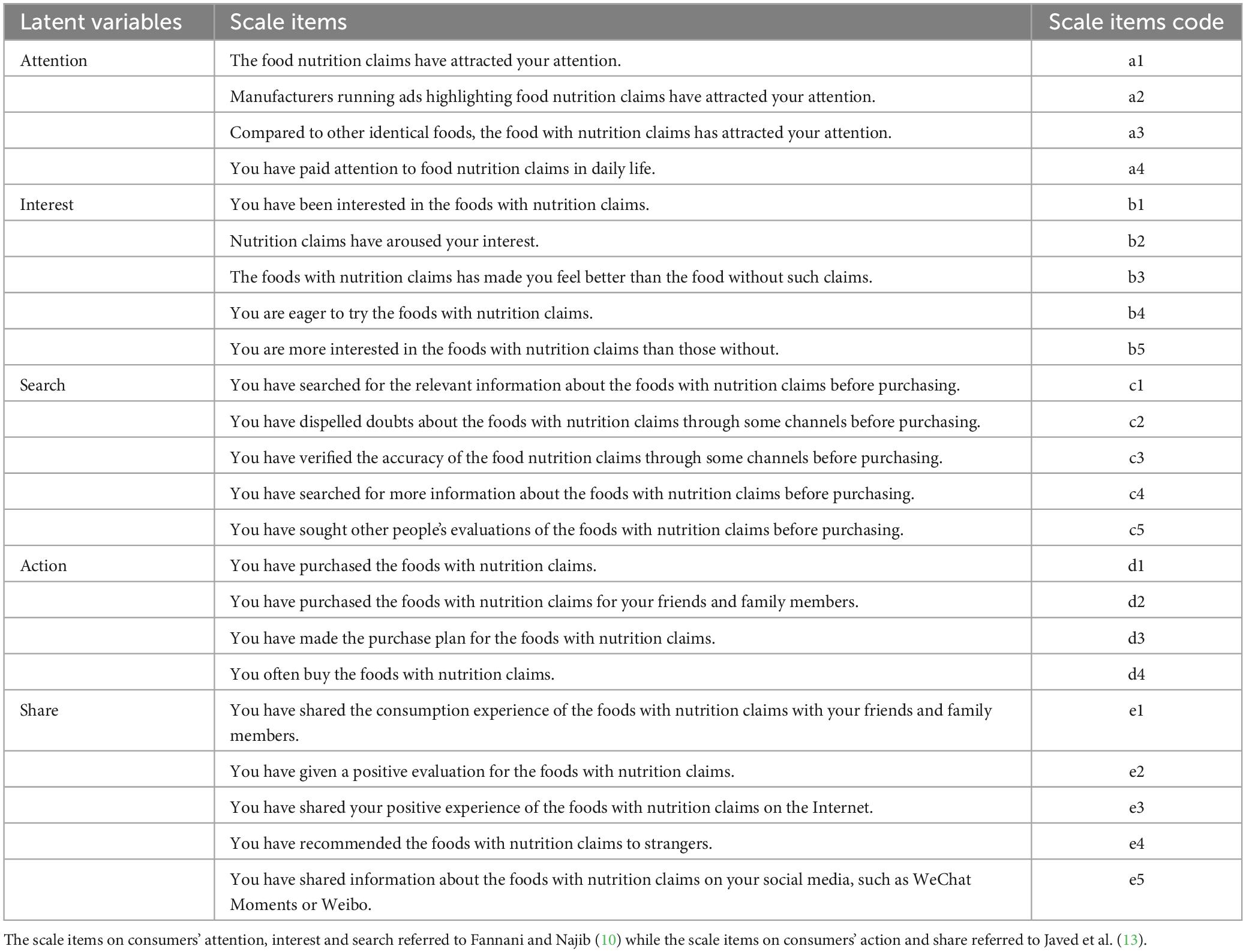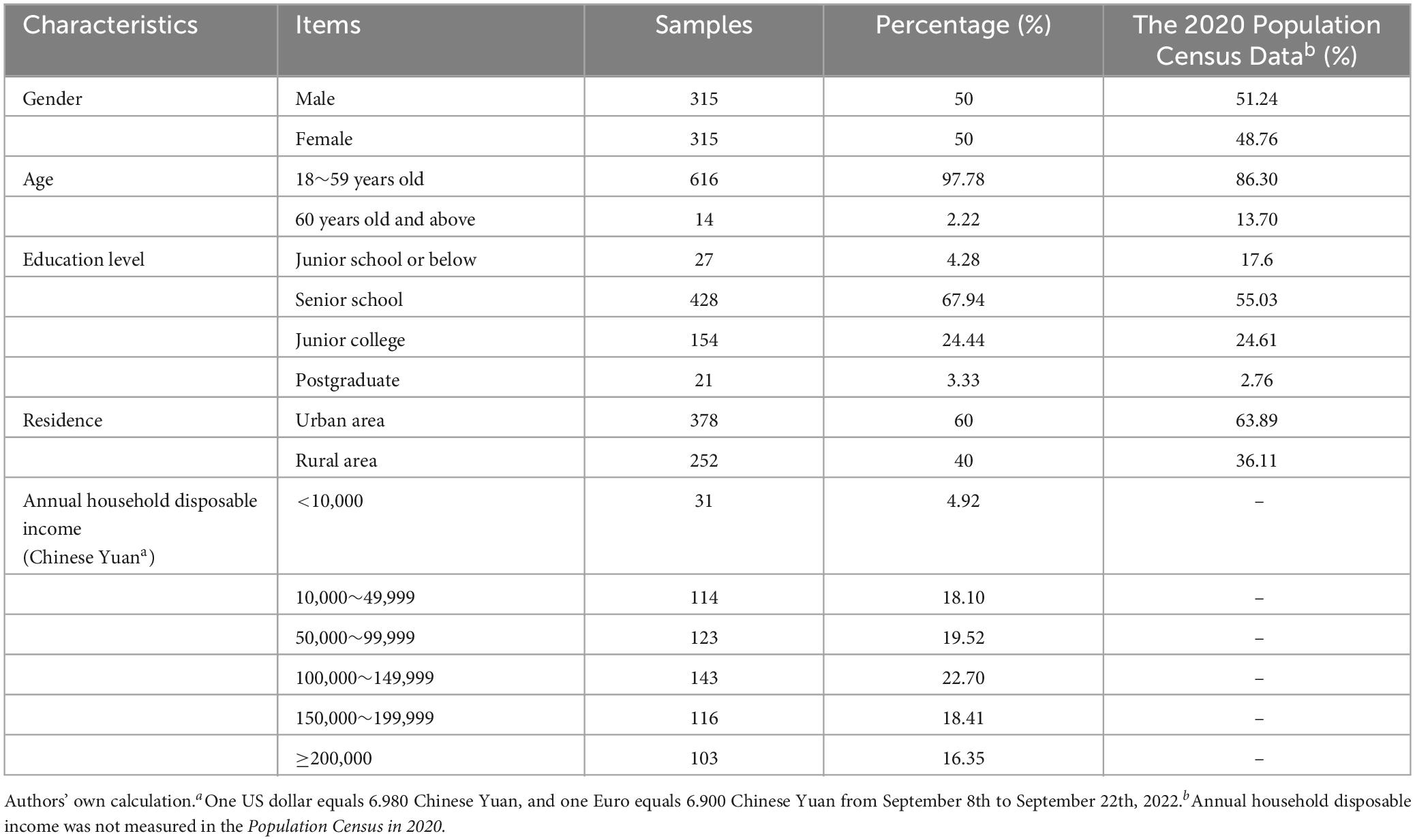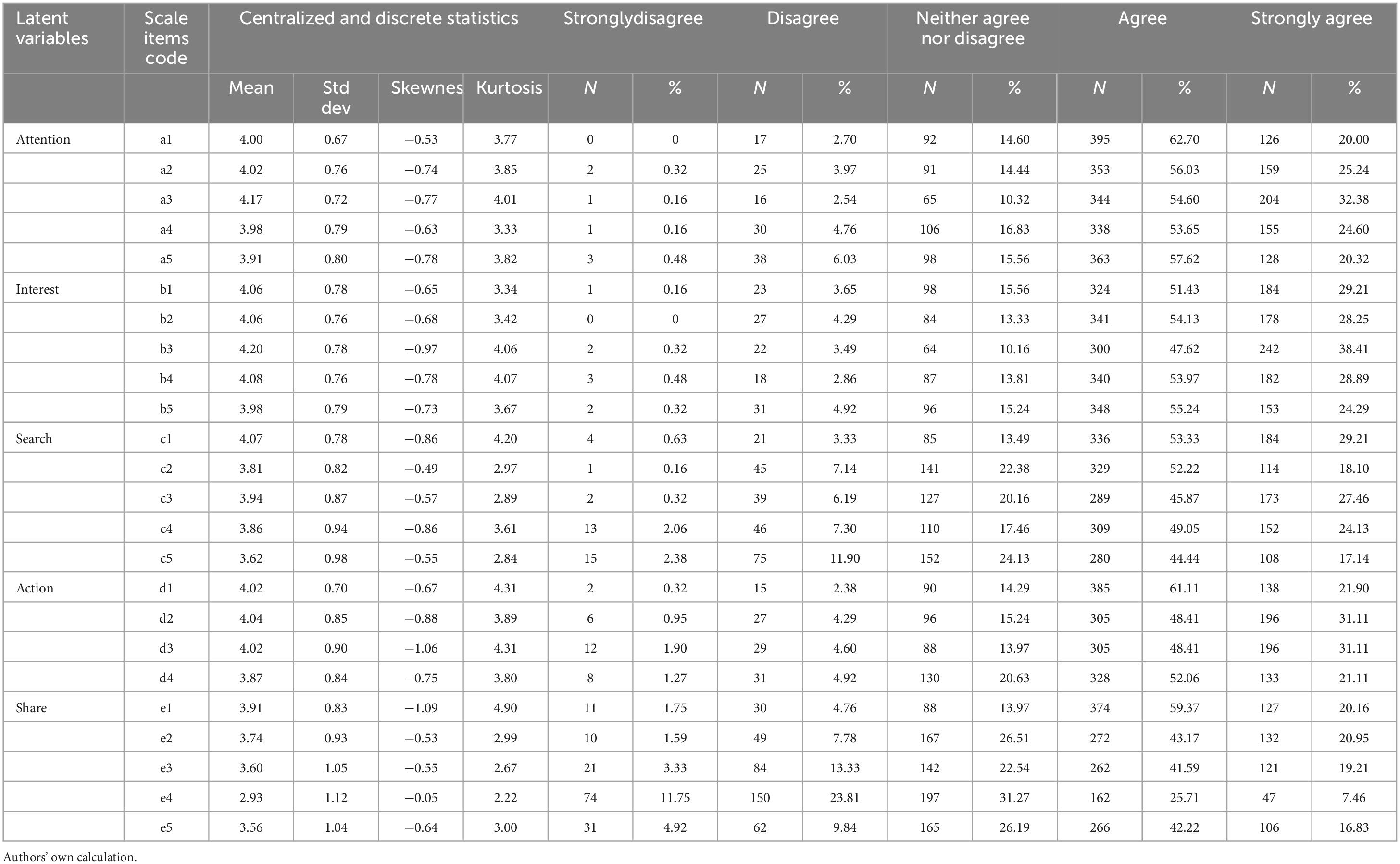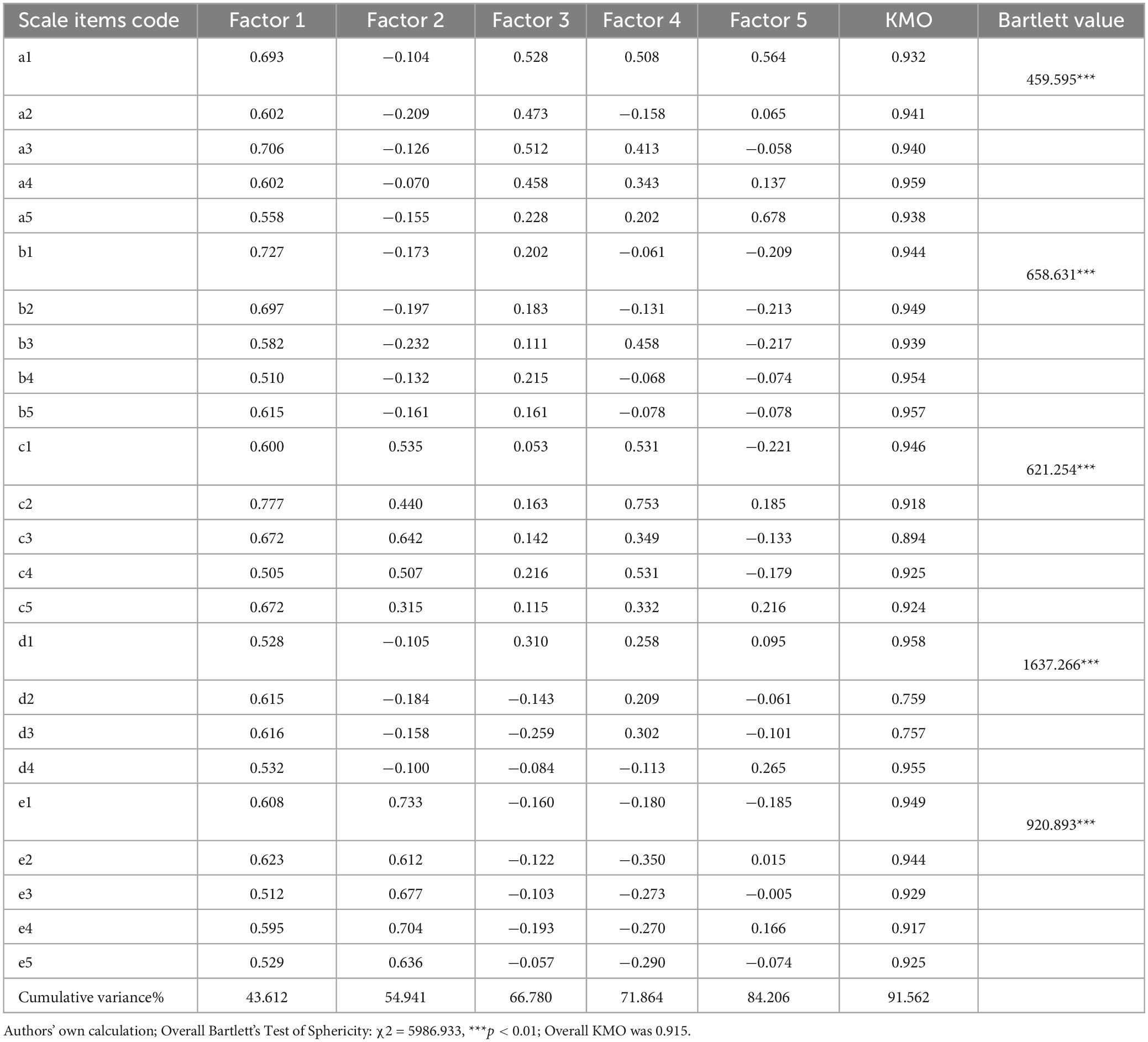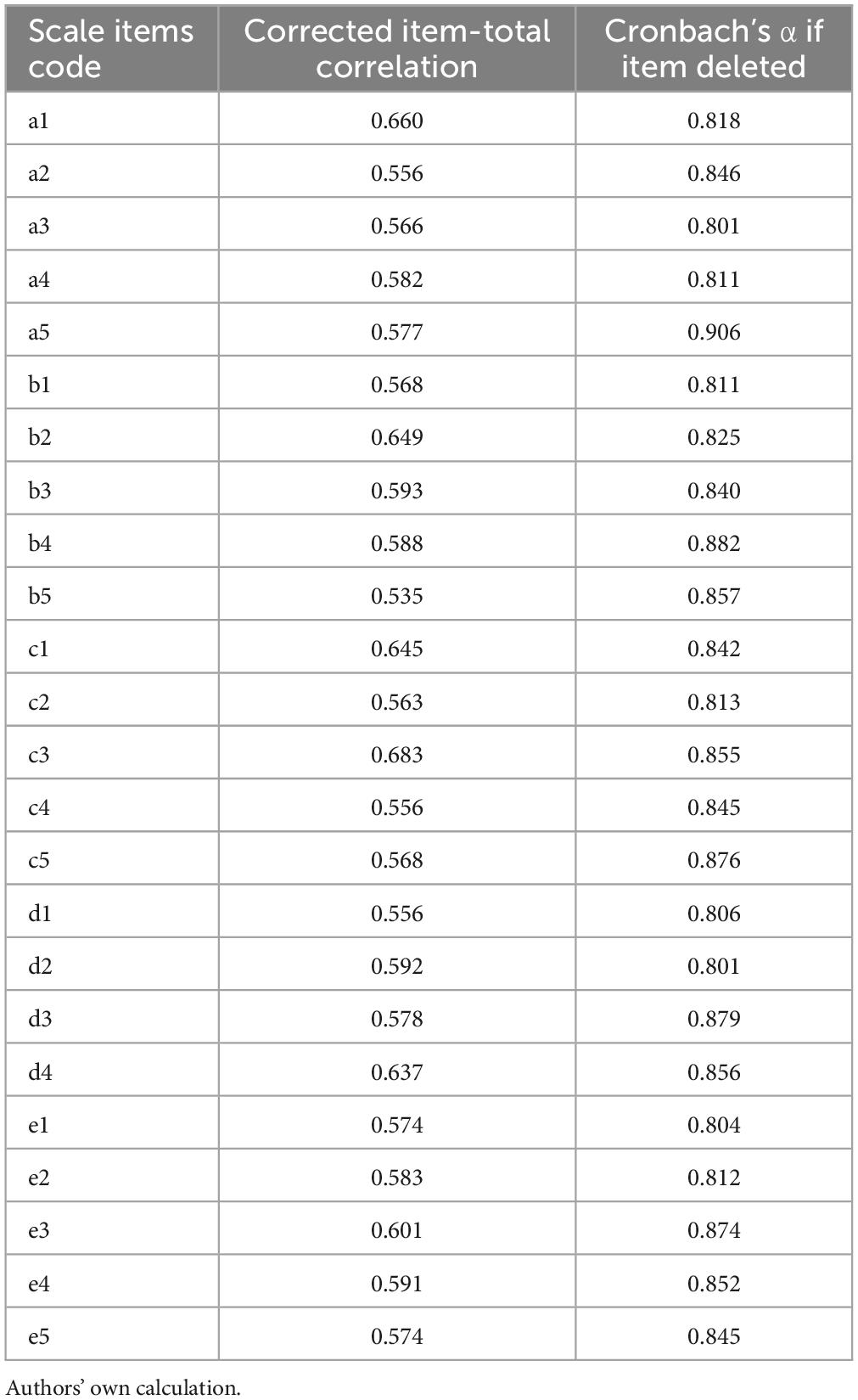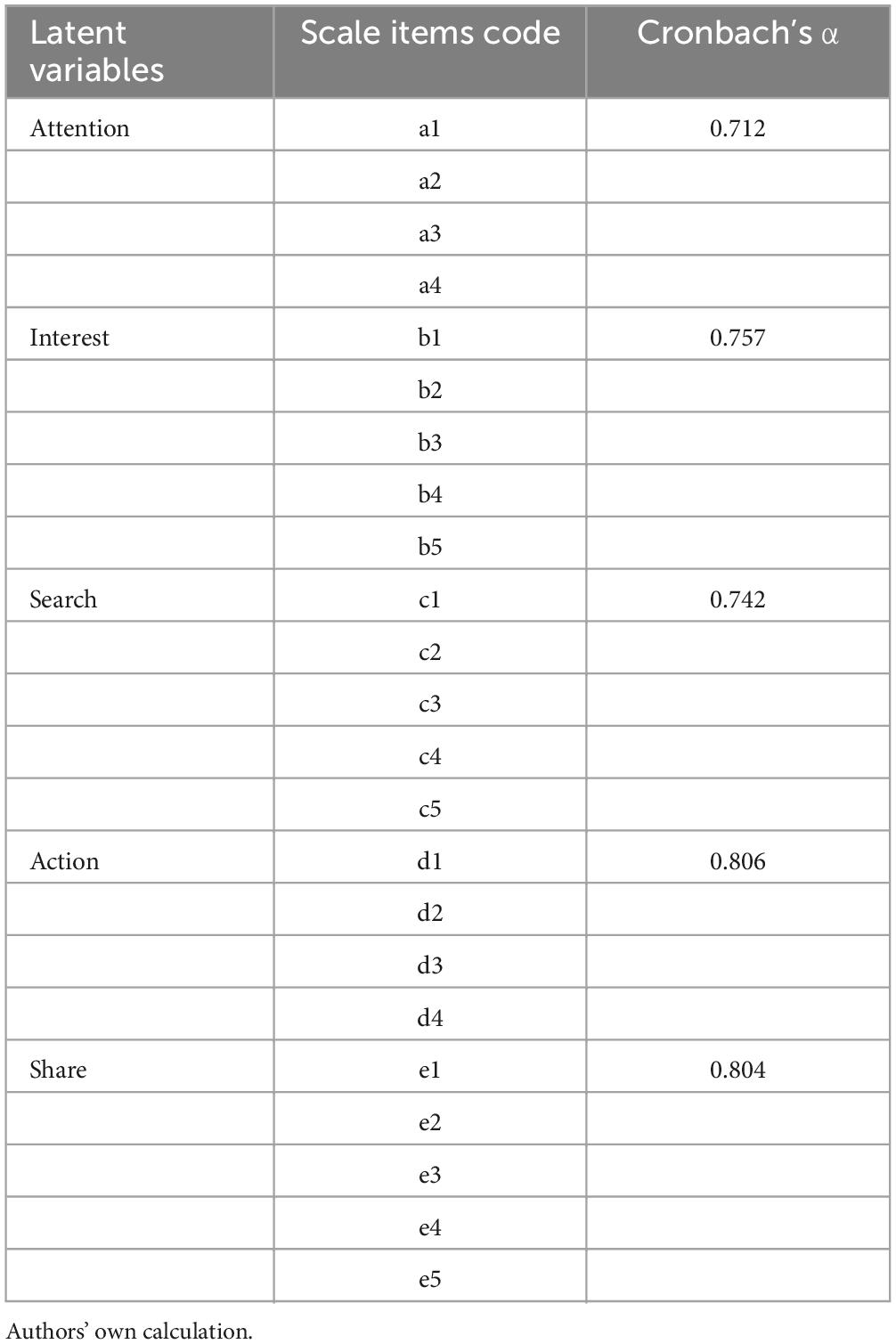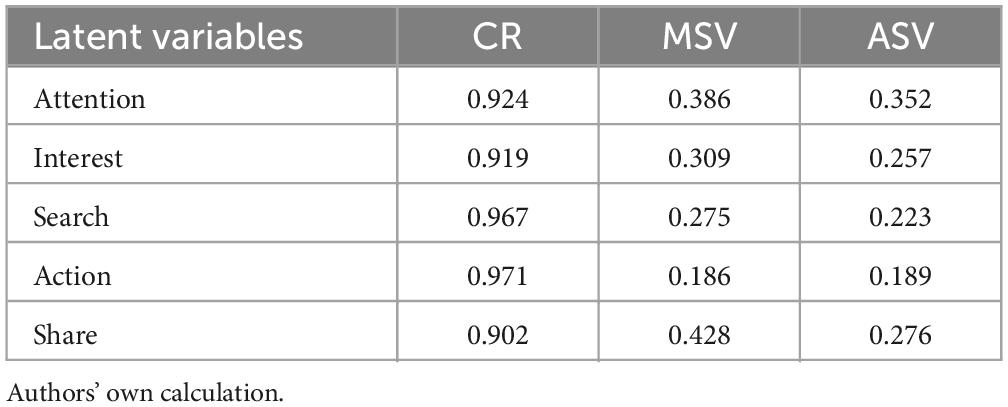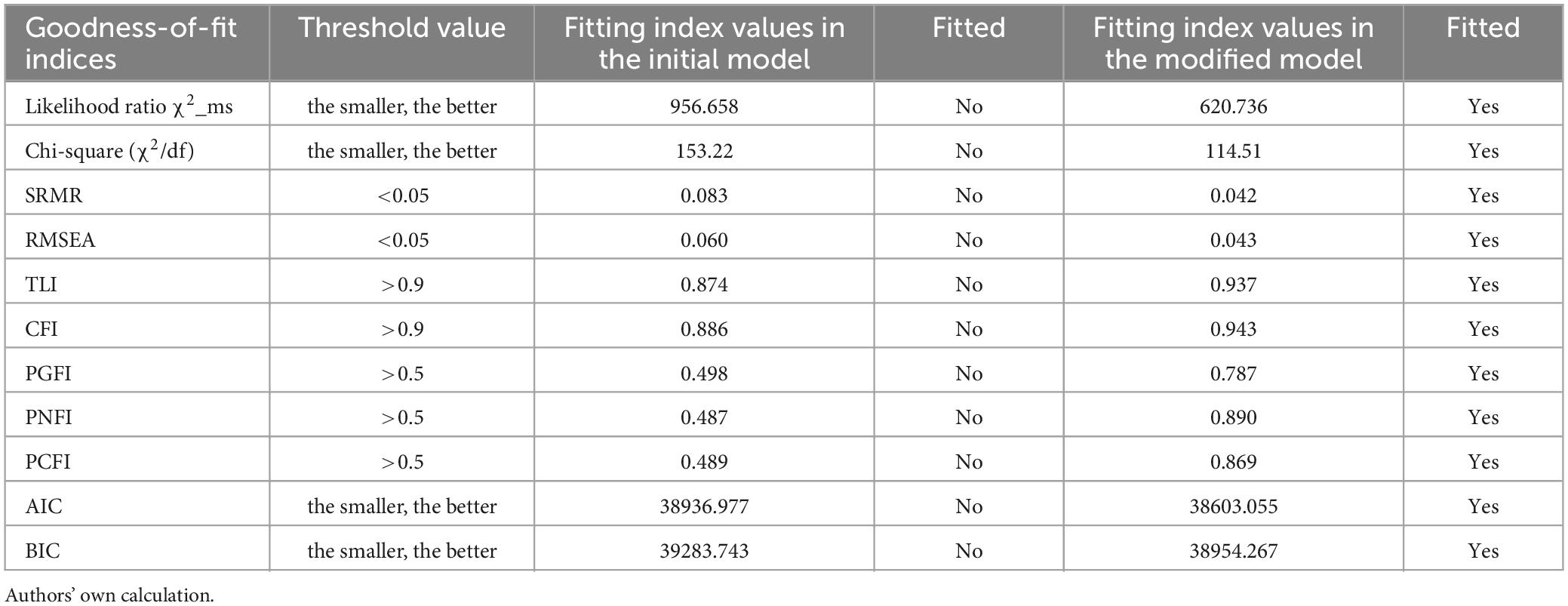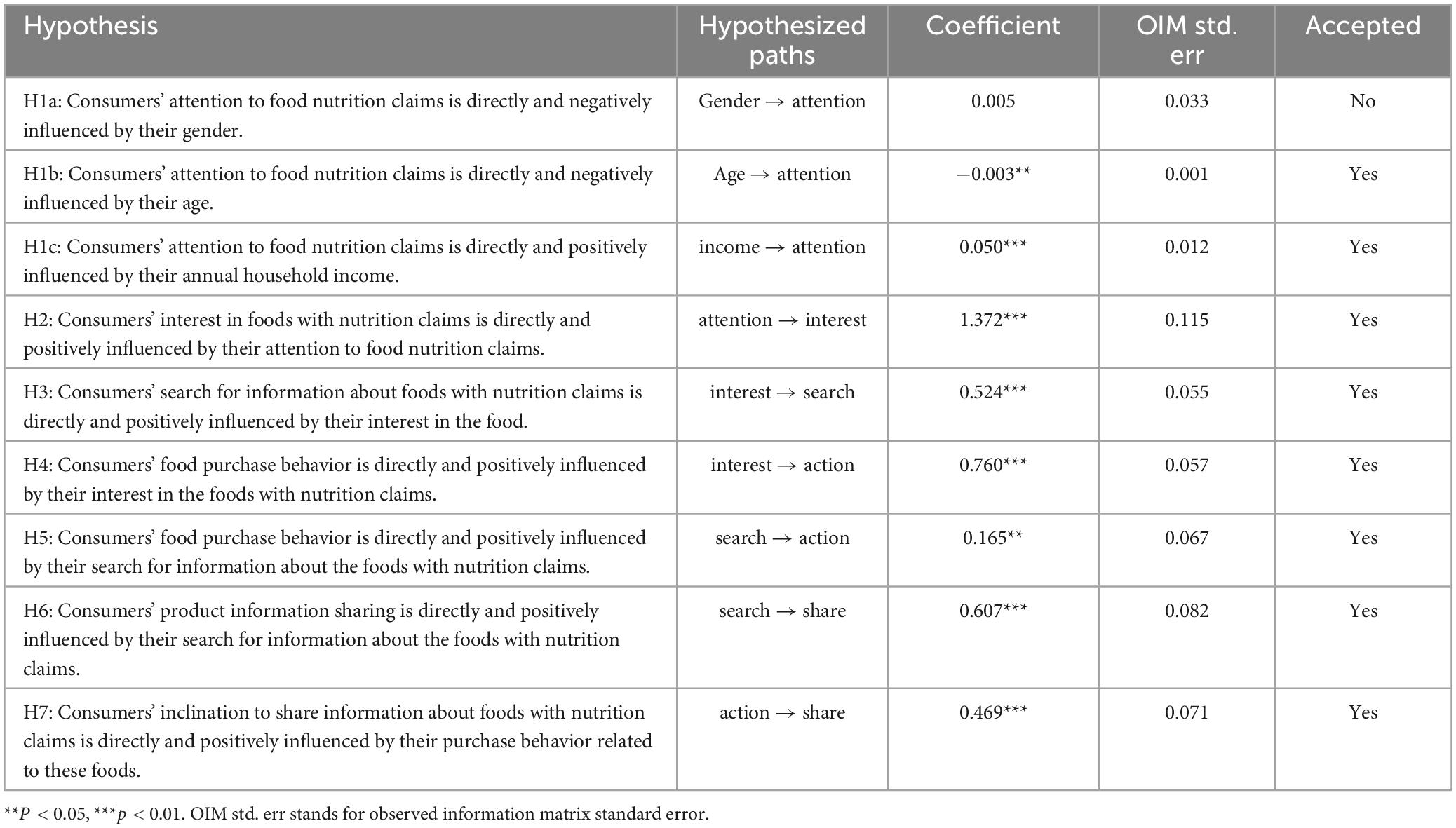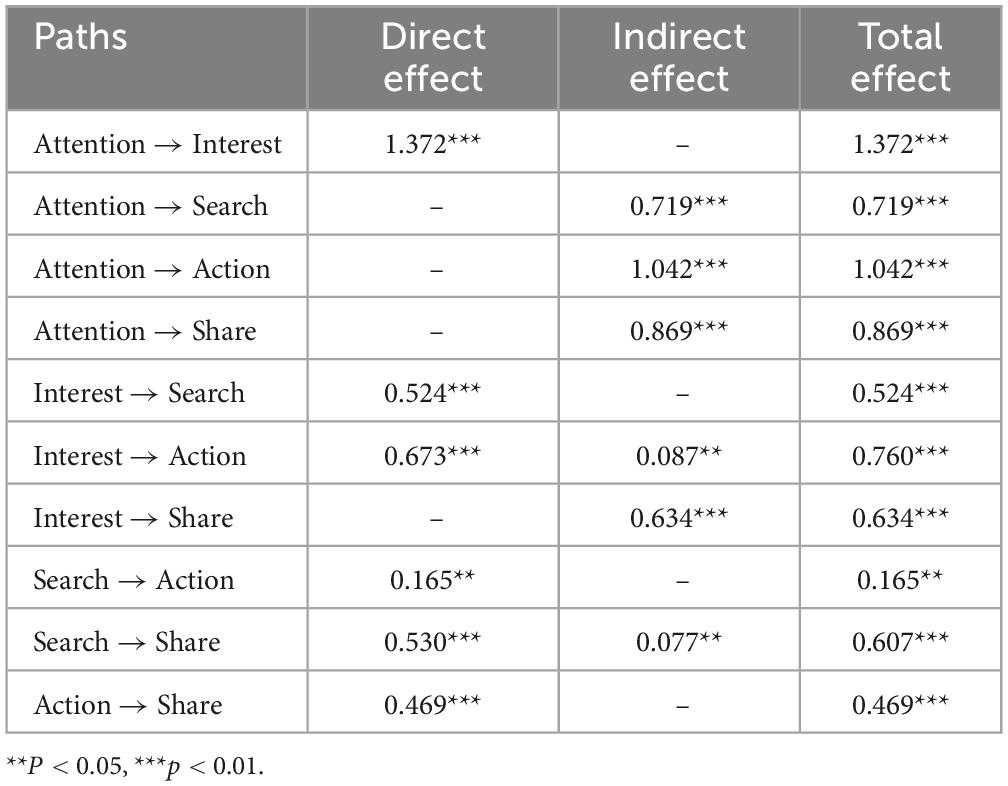- 1Institute of Food and Nutrition Development, Ministry of Agriculture and Rural Affairs, Beijing, China
- 2School of Information and Intelligence Engineering, University of Sanya, Sanya, Hainan, China
Objective: We analyzed the impact of nutrition claims on Chinese consumer psychology and behavior process based on the theoretical framework of AISAS (Attention-Interest-Search-Action-Share) model.
Design: To adopt questionnaires to collect gender, age, income and other basic information of adult residents and a 5-point Likert scale ranging from 1 (strongly disagree) to 5 (strongly agree) to collect data on residents’ attention to nutrition claims, interest in nutrition claims, search on nutrition claim information, purchasing behavior on food with nutrition claims, sharing information on food with nutrition claims. Then to study the relationship between the basic situation of residents and their attention, interest, search, food purchase behavior and sharing of nutrition claims by using exploratory factor analysis, reliability and validity test, structural equation modeling estimation and hypothesis testing.
Participants: Chinese adults.
Setting: Multi-stage stratified random sampling method was used to collect the valid online questionnaire of 630 Chinese adults from Central, North, East, South, Northwest, Southwest, and Northeast China.
Results: Younger adults and those with higher household incomes exhibited heightened attention to nutrition claims. Furthermore, consumers’ attention to nutrition claims could be transformed into food information sharing through interest, information search, and food purchase. Consumers’ interest in food with nutrition claims could be transformed directly into food purchase. Consumers’ search for related information could be directly transformed into food information sharing.
Conclusion: Chinese consumers’ age and household income could be included in the AISAS model for the foods with nutrition claims, and the consumers’ action and share could transform from their interest and search.
1 Introduction
At present, the dietary habits of Chinese adults are characterized by elevated consumption of oil and salt, accompanied by inadequate intake of whole grains, dark vegetables, fruits, milk, fish, shrimp, and beans. This dietary pattern leads to excessive sodium and saturated fatty acid intake and insufficient consumption of calcium, dietary fiber, and vitamin C (1). Therefore, the supply of food with low sodium, low fat, high calcium, rich dietary fiber, and rich vitamin C can effectively cater to residents’ requirements for a nutritious and healthy diet. The nutrition claim is a nutrition labeling that describes the positive nutritional and health properties of the foods. Marking methods and content requirements for nutrition claims on prepackaged foods have been regulated in the National Food Safety Standard of General Rules for Nutrition Labeling of Prepackaged Foods (GB 28050—2011) since 2011 (2). Therefore, there has been a growing number of prepackaged foods labeled with such claims in the marketplace.
Although the nutrition claim is a policy tool developed by the Chinese government for consumers to make nutritious and healthy food choices (3). However, whether and how consumers react to nutrition claims on foods is not only the basis for public authorities to evaluate nutrition policies, but also one of the indicators for manufacturers to test the market share of nutritious and healthy foods. In addition, China’s nutrition claims are introduced during the mobile Internet era when people are willing to search and share information (4). In this context, consumer responses to nutrition claims may also include the active search and sharing of nutrition claim information. However, the current research mainly focuses on consumers’ attention, interest, cognition and purchasing behavior of nutrition claims, but has not yet studied how consumers search and share nutrition claims information in the era of mobile Internet. Therefore, it is innovative to carry out research on consumers’ psychological and behavioral processes of food nutrition claims, including search and information sharing, which could understand the nutritional needs and consumption behaviors of consumers in the new era, expanding and strengthening the explanatory power of consumer behavior theories with China experience, and providing decision-making basis for governments in other countries to adjust and improve supporting measures for nutrition claims. It also provides persuasive evidence for food manufacturers to produce nutritious and healthy foods.
The remaining parts of this study are as follows: the second part summarized the research progress of the impact of nutrition claims on consumers’ psychology and behavior process; the third part proposed research hypotheses; the fourth part introduced the data sources and research methods; the fifth part implemented reliability and validity test and structural equation model estimation; the sixth part discussed the results; the final part is the conclusion and inspiration.
2 Literature review
At present, the behavior pattern of consumers in the era of mobile Internet was studied mainly with the Attention-Interest-Search-Action-Share (AISAS) model proposed by Dentsu Co., LTD in 2005 based on the Attention-Interest-Desire-Memory-Action (AIDMA) model which aims to explore consumers’ psychology and behavior in the Internet era (5). As shown in Figure 1, the AISAS model consists of attention, interest, information search, action, and experience sharing. AISAS model was widely used in online and offline marketing effectiveness evaluation of Fast Moving Consumer Goods (FMCG), durable goods and services, involving coffee, seafood, intelligent pension products, hotel accommodation, tourism service, the Augmented Reality (AR) wedding invitation app, AI-generated cultural and creative products, advertising on social networking site and organic food sold on social media. Among them, some studies extended the AISAS model according to characteristics of the products and service (6–15). For example, the social latent variables were added to the AISAS model to construct the Attention-Interest-Search-Social-Action-Share (AISSAS) model to analyze consumers’ usage behavior of the AR wedding invitation app (8). Most studies have proved that AISAS model and its extended model could effectively explain consumer psychology and behavior to products and service marketing (6–9).

Figure 1. AISAS model. Source: Dentsu Inc (5).
There have been a number of studies on the impact of nutrition claims on consumer psychology and behavior. Through questionnaire design, scholars mainly investigated consumers’ preference, health perception, interest, willingness to pay and attention, brand loyalty, purchase decision and food choices (16–31). There also existed a few studies on the relationship between individuals’ psychology and behavior such as interest in foods with nutrition claims and purchase decision (21, 32). Studies have consistently concluded that nutrition claims had a “health halo”, which could improve consumers’ cognition of food quality, consumption confidence (17, 18, 24, 27, 28).
The existing studies on the impact of nutrition claims on consumers’ psychology and behavior were not systematic and in-depth enough to fully reveal the consumers’ reactions to nutrition claims, which failed to effectively design the promotion and marketing strategy of nutrition claims. By referring to the former studies on AISAS model and its application, we aimed to analyze the impact of nutrition claims on consumer psychology and behavior process by expanding the AISAS model and using the questionnaire survey data of Chinese consumers.
3 Hypotheses
The Figure 2 shows that the AISAS hypothesis model is proposed based on the framework of the AISAS model and the characteristics of foods with nutrition claims. The AISAS model does not include consumers’ socio-economic characteristics, rendering it incapable of discerning which demographic segments are more likely to pay attention to product marketing advertisements. Most studies have found that consumers who were female, younger or had higher household income paid attention to nutrition claims (33–36). It could be seen that gender, age and annual household income were the individual characteristics that significantly affected consumers’ attention to nutrition claims. Therefore, this study aims to incorporate these three individual characteristics to formulate the following research hypotheses:
H1a: Consumers’ attention to food nutrition claims is directly and negatively influenced by their gender.
H1b: Consumers’ attention to food nutrition claims is directly and negatively influenced by their age.
H1c: Consumers’ attention to food nutrition claims is directly and positively influenced by their annual household income.
The AISAS model clarifies that consumers’ interest in products is directly and positively affected by their attention to product advertising (5). Moreover, European consumers’ interest in nutrition labeling were found to be derived from attention (37, 38). It is inferred that consumers who pay attention to food nutrition claims are likely to be interested in foods with nutrition claims, so the following research hypothesis is proposed:
H2: Consumers’ interest in foods with nutrition claims is directly and positively influenced by their attention to food nutrition claims.
The AISAS model clarifies that consumers’ search for product-related information is directly and positively affected by their interest in products (5). It is also found that if nutrition labeling raised consumers’ interest, consumers would search more information about the product (39, 40). It is inferred that consumers who are interested in foods with nutrition claims are likely to search for information about those foods. Therefore, the following research hypothesis is proposed:
H3: Consumers’ search for information about foods with nutrition claims is directly and positively influenced by their interest in the food.
The AISAS model illustrates that consumers’ interest in products could only be transformed into product purchase through information search (5). Given the more affordable nature of food products featuring nutrition claims compared to items related to personal development and enjoyment (e.g., education, healthcare, entertainment, and cultural services), some consumers may be inclined to expedite their purchase decisions without extensive information search (21, 32). Consequently, the research hypothesis is as follows:
H4: Consumers’ food purchase behavior is directly and positively influenced by their interest in the foods with nutrition claims.
The AISAS model clarifies that consumers’ product purchase is directly and positively affected by their search for product-related information (5). And consumers’ search for information about foods with nutrition and health claims was found the final step that translated into foods purchasing (38). So it is inferred that consumers who search for information about foods with nutrition claims are likely to buy the foods with nutrition claims and the following research hypothesis is proposed:
H5: Consumers’ food purchase behavior is directly and positively influenced by their search for information about the foods with nutrition claims.
The AISAS model clarifies that the influence of consumers’ product information search on product information sharing goes through the food purchase process (5). In reality, some consumers without product purchase experience still share their product evaluations through we-media platforms (41). The former study proved that consumers who searched information about foods with nutrition and health claims were likely to share the relevant information (21). Therefore, the following research hypothesis is proposed:
H6: Consumers’ product information sharing is directly and positively influenced by their search for information about the foods with nutrition claims.
The AISAS model clarifies that consumers’ sharing of products is directly and positively influenced by their food purchase behavior (5). Furthermore, there was a high probability that consumers who purchased the foods with nutrition claims shared their experience (39, 42). It is inferred that consumers who have bought the foods with nutrition claims tend to share the food information. Therefore, the following research hypothesis is proposed:
H7: Consumers’ inclination to share information about foods with nutrition claims is directly and positively influenced by their purchase behavior related to these foods.
4 Materials and methods
4.1 Data collection
As indicated in Table 1, the five latent variables in the AISAS model could be measured by scale items, with respondents providing their answers on a 5-point Likert scale ranging from 1 (strongly disagree) to 5 (strongly agree). Our questionnaire (see Supplementary material) was refined based on feedback from a pre-survey involving 30 adults in Beijing, China. We utilized a paid online survey service of Wenjuanxing,1 a reputable online survey platform in China with a database of 6.2 million registered members of different ages across 31 provinces/autonomous regions/municipalities (referred to as ‘province’ hereafter).
This study adopted multi-stage stratified random sampling method. Due to the fact that people in Northeast China, North China, Northwest China, East China, Central China, Southwest China, and South China have different eating habits, China was divided into the above seven regions in the first stage, and then one province was randomly selected from these regions (43). The seven provinces were Jilin, Inner Mongolia, Shaanxi, Shandong, Henan, Sichuan, and Guangdong. Finally, according to the minimal number of representative, random samples (N = 600) in China was determined with an allowable error of 4% and a confidence level of 95%, at least 86 samples collected from each selected province on average. Therefore, we commissioned Wenjuanxing to collect target sample size from its member database. From September 8th to September 22nd, 2022, Wenjuanxing emailed the questionnaire link to 130 adults randomly selected from each province, and about 88.13% participated in the online survey. Before data collection, informed written consent was obtained from all participants. Eight Chinese Yuan as cash incentives were offered to each respondent if their responses were careful and complete. Finally, after data validity was checked, 630 valid samples were used for analysis.
4.2 Methods
Although the linear regression model could be used to analyze consumer behavior based on AISAS model (12), most previous studies adopted the structural equation model to analyze the internal relationship between consumers’ attention, interest, search, action and sharing (11, 15). Therefore, we intended to use this method. Structural equation modeling allows the creation of observable variables per construct, which does not require split analysis and yields valid and clear inferences (44). Thus, the results of the relationships among variables were reliable and neutral (45). In addition, structural equation modeling is capable of scrutinizing complex correlations and a range of hypotheses by immediately incorporating mean structures and group estimation (46).
According to the influence paths in Figure 2, the hypotheses proposed above were made out by the structural equation modeling which consists of a structural model and a measurement model.
The formula above is a structural model. η are the latent variables of the AISAS model. B are the relationships between latent variables. ξ are exogenous variables such as gender, age and annual household income. Γ is the influence of exogenous variables on individuals’ attention to nutrition claims. ζ is the residual term.
The formula above is a measurement model. Y are explicit variables. is the correlation coefficient matrix of latent variables (i.e., attention, interest, search, action, share) and their explicit variables. ϵ is measurement error.
Then the built model estimation was conducted in two steps. Firstly, the reliability and validity test was performed to evaluate the stability and consistency of measured items in the measurement model with the SPSS Statistics 24.0 and AMOS Statistics 26.0. Secondly, the evaluation of goodness-of-fit indices for the proposed structural equation modeling and tests of hypotheses were made by means of moment structure analysis with Stata Statistics17.0 to obtain the direct effect, indirect effect and total effect among latent variables.
5 Results
5.1 Descriptive statistics
As shown in Table 2, the distribution of samples’ gender and residence closely resembled the Main data of the 7th National Population Census in 2020 (47). This validates the representativeness of the overall sample despite of low proportion of the population aged 60 and above and with junior high school education and below.
Based on the information provided in the Table 3, several conclusions can be drawn regarding respondents’ perceptions and behaviors in relation to the marketing of foods with nutrition claims.
As for attention, the majority of respondents (62.70%) agreed that the food nutrition claims attracted their attention. There existed variability, indicated by the standard deviation of 0.67. As for interest, there was significant interest from respondents in foods with nutrition claims, with around 86.03% of them agreeing that these foods made them feel better than those without such claims. Variability in responses existed, suggested by the standard deviation of 0.78. As for search, respondents appeared to search for information about foods with nutrition claims, but there was significant variation in the level of search, indicated by the standard deviation of 0.87. A few people (3.33%) indicated that they completely agreed with actively seeking information. As for action, most respondents (83.01%) agreed or strongly agreed that they bought foods with nutrition claims, but there was variability, suggested by the standard deviation of 0.70. As for share, there was a variety of attitudes regarding sharing information about foods with nutrition claims, and the lowest percentage was associated with recommending these foods to strangers (20.16%). There was significant variation in the level of sharing, indicated by the standard deviation of 0.83.
5.2 Exploratory factor analysis
As was shown in Table 4, the Kaiser-Meyer-Olkin (KMO) statistics of scale items and overall KMO statistics were above 0.7 and the approximate chi-square value of Barlett’s sphericity test of five latent variables and overall Bartlett value were statistically significant. It means that the samples were suitable for exploratory factor analysis. The results of factor loading after rotation indicated that eigenvalue of 5 factors were greater than 1, and the cumulative contribution rate was more than 80%.
5.3 Reliability and validity test
As seen from Table 5, the corrected item-total correlation coefficients of all scale items were greater than 0.5, indicating a strong correlation between scale items. All the Cronbach’s α were above 0.8 if any item was deleted. However, the Cronbach’s α was highest (0.906) if a5 was deleted.
Table 6 shows that Cronbach’s α of each latent variable was greater than 0.7 when deleting a5, indicating that the scale reliability was good.
As shown in Table 7, Average Variance Extracted (AVE) of all constructs were more than 0.7. It means that constructs had high reliability and convergence validity. The discriminant validity among constructs were assessed with Maximum of shared squared variance (MSV) and Average of shared squared variance (ASV), and Table 8 showed that the scale could distinguish different dimensions or concepts to a high degree.
5.4 Structural equation modeling estimation and hypothesis testing
Table 9 displays the goodness-of-fit indices for the initial and modified models. None of the fitting indexes of the initial model reached the threshold value. The initial model was modified by adding the residual correlation path between explicit variables (i.e., d2 and d3). The fitting index values such as Standardized Residual Mean Root (SRMR), Root Mean Square Error of Approximation (RMSEA), Tucker-Lewis Index (TLI), Comparative Fit Index (CFI), Parsimony Goodness-of-Fit Index (PGFI), Parsimony Normed Fit Index (PNFI) and Parsimony Comparative Fit Index (PCFI) outperformed the respective threshold values, signifying that the model was able to fit all data satisfactorily. Likelihood ratio χ2_ms, χ2/df, Akaike Information Criterion (AIC) and Bayesian Information Criterion (BIC) in the modified model were smaller than those in the initial model.
Figure 3 shows the estimation result of the modified model. All hypotheses were supported at the statistical significance level except for the influence of gender (Table 10). To be more specific, consumers’ attention to food nutrition claims were negatively influenced by their age and positively influenced by their annual household income so H1b and H1c were supported. However, consumers’ gender took insignificant effect and H1a was not accepted. As expected, consumers’ attention posed positive influence on their interest which had positive influenced their search for information about foods with nutrition claims and food purchase behavior. Therefore, H2, H3, H4 were accepted. Furthermore, consumers’ search for the information positively affected their food purchase and sharing, supporting H5 and H6. H7 was also supported because consumers’ product information sharing was influenced by their food purchase behavior.
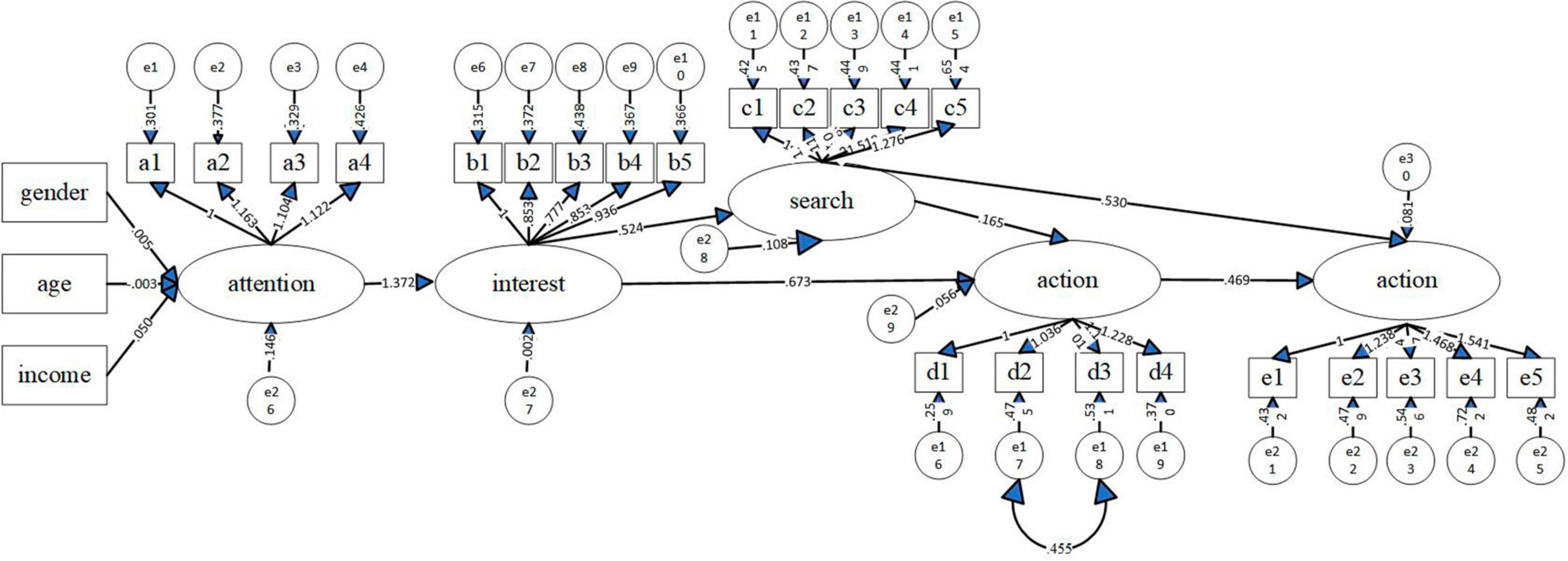
Figure 3. Modified structural equation modeling results. e1∼e25 are the residuals of explicit variables. e26∼e30 are the measurement errors of latent variables, Source: Authors’ own illustration.
As shown in Table 11, among the influence paths, the effect of respondents’ attention to food nutrition claims on their interest in the food with such claims had the most significant total effect (1.372). It was followed by the influence of attention on food purchase (1.042), the influence of attention on information sharing (0.869), the influence of interest on food purchase (0.760), and the influence of attention on search for information about such foods (0.719).
6 Discussion
6.1 Association between Individuals’ socio-economic status and attention
Respondents’ gender did not have a direct and significant impact on their attention to food nutrition claims. It is inconsistent with previous studies that female groups were likely to pay attention to nutrition claims (33, 34). This may be due to the fact that food nutrition claims in China conveyed information that appealed to both men and women, so there were not significant gender differences in consumers’ attention to nutrition claims. In addition, respondents’ age and annual household income significantly and directly affected their attention to food nutrition claims. Specifically, the increase in age significantly decreased respondents’ attention to such claims, while the increase in annual household income raised respondents’ attention to the claims. This finding was in accordance with the studies of Klopčič et al. (36) and Vyth et al. (48) Compared with relevant studies on the improved AISAS model by incorporating latent variables (9, 13), the AISAS model in our study, which incorporated external variables including age and annual household income, represented an innovative and valuable approach for identifying the characteristics of consumers who were attentive to food nutrition claims.
6.2 Association between attention and interest
Respondents who paid attention to food nutrition claims increased interest in such claims, consistent with the theoretical prediction of the AISAS model (5) and relevant empirical studies that confirmed consumers’ interest was determined by their attention (11, 13). In our study, attention had the most significant influence on interest (1.372), indicating that respondents’ attention to nutrition claims was most likely to transform into interest compared to other influence paths. However, other studies argued that, of all the paths, interest had the greatest impact on search or search had the greatest impact on purchase (12, 14). This is because our study took food nutrition claims as the research object. Only when nutrition claims were paid attention could consumers become interested, and then other behaviors such as searching, buying and sharing would be carried out.
6.3 Association between interest and search
Respondents interested in foods with nutrition claims tended to search for information about such foods, which was consistent with the expected theoretical predictions of the AISAS model (5) and the studies’ results (14, 15). However, the difference is that the limited effect of respondents’ interest on their information search (0.524) in our study suggested a low probability of transforming interest in foods with nutrition claims into information search. Perhaps this is due to that China’s nutrition claims was authoritative and enforced by the government. Consumers who were interested in nutrition claims were generally less likely to search for information and convert it directly into buying behavior.
6.4 Association between interest and action
Respondents’ interest in foods with nutrition claims directly and positively influenced their purchase behavior of those foods. It indicates that emotionally driven consumers tended to consume impulsively without searching for information despite the convenience of information access in the mobile Internet era. This finding differed from the theoretical prediction of the AISAS model that represented the one-way progressive progress of interest → search → action, but was in accordance with the previous studies’ results that consumers who were interested in food nutrition claims had high probability in purchasing foods labeled with nutrition claims (21, 32). Like other studies (12, 14), this study also found that in practice, consumers did not strictly follow the theoretical model of the AISAS model, which provided Chinese experience for expanding the AISAS model.
6.5 Association between search and action
Respondents who searched for information about the foods with nutrition claims tended to buy food, which was consistent with the theoretical prediction of the AISAS model (5) and other studies (13, 15). However, among the many influence paths, food information search had the smallest influence on food purchasing (0.165). It implied a limited motivation for food information searchers to buy the food with nutrition claims. This is because Chinese respondents interested in the foods with nutrition claims may search for information to fully understand the food before shopping, or they may make consumption decision without searching for relevant information.
6.6 Association between search and share
Respondents who actively searched for information about the foods with nutrition claims were likely to share food consumption experience and information, which was not same with the theoretical prediction of the AISAS model that represents the one-way progressive progress of search → action → share (5), but was consistent with the former findings that search could have a direct impact on sharing (12, 21). It was possibly because that certain consumers who engaged in information search but lacked actual shopping experience were still willing to share the information of food with nutrition claims on we-media platforms due to the low cost of online information search.
6.7 Association between action and share
Respondents who bought the foods with nutrition claims tended to share food shopping experiences and information, consistent with the theoretical prediction of the AISAS model (5) and the relevant studies’ conclusion (13, 14). This confirmed that in the era of mobile Internet, many consumers had mobile devices such as cell phones. Consumers who had a good experience in buying food with nutrition claims tended to share their purchasing experience on social media to attract potential consumers to pay attention to the food with nutrition claims. In this way, a virtuous circle would be formed. Through word-of-mouth marketing, more people would be encouraged to buy nutrition and health food, and finally the nutrition and health level of the whole society could be improved.
7 Conclusion
This study aimed to investigate consumers’ psychology and behavior of foods with nutrition claims using questionnaire data collected from 630 adults across representative regions in China, employing the AISAS model. The findings suggested that the AISAS model with individual socio-economic characteristics and non-unidirectional progression was suitable for analyzing the reaction of Chinese adults to foods with nutrition claims. Younger adults and those with high annual household income were likely to pay attention to food nutrition claims. Consumers’ attention and interest in food nutrition claims were transformed into information search, food purchase, and experience sharing.
Our results proved that nutrition claims were able to guide specific Chinese consumer groups to make purchase decision especially share their opinion about the foods with nutrition claims, thus there were perhaps some theoretical and practical contributions of this study. Firstly, the expansion of AISAS model theory was supported by the present empirical study in China, highlighting that individuals’ socio-economic characteristics could be included in the model, and the people’s action and share could also transform from interest and search, respectively, so the updated model may have high efficiency of explanation and prediction for more forms of products’ advertising marketing. Secondly, our study was likely to provide the basis for the public sector to continue promoting nutrition claims to implement the national dietary nutrition health interventions and for enterprises to actively label nutrient-rich foods with nutrition claims which was sold in subdivided groups.
This study is subject to certain limitations which will be solved in future research. Firstly, our sample size is relatively small in comparison with China’s large population, which may restrict the generalizability of our findings to broader studies. Secondly, the model did not regard the social environment as an external factor, despite the proven role of social and economic factors in shaping individuals’ psychology and behavior. Thirdly, scale items measuring consumption process of the foods with nutrition claims with self-report questionnaires are biased toward subjectivity. However, self-report questionnaires are vulnerable to social desirability bias due to respondents tendencies to answer in a more socially acceptable way. Therefore, for accurate research results, more attempts are needed, involving a larger sample, adding social environment variables and employing indirect questioning methods such as the list experiment.
The following implications are offered: Firstly, manufacturers may focus on younger demographics and groups with higher household incomes when developing marketing strategies for food products with nutrition claims to promote the broader consumption of nutritious and healthy foods. Secondly, consumers could be encouraged to share their consumption experience and food evaluation online to guide more consumers to purchase food. Thirdly, public sectors could formulate favorable policies and incentive measures to encourage enterprises to supply more foods with nutrition claims, ultimately contributing to enhancing balanced nutrition and promoting healthy diets nationwide.
Data availability statement
The original contributions presented in the study are included in the article/supplementary material, further inquiries can be directed to the corresponding authors.
Ethics statement
The study was conducted in accordance with the Declaration of Helsinki, and approved by the Ethics Committee of Institute of Food and Nutrition Development, Ministry of Agriculture and Rural Affairs for studies involving humans. Informed consent was obtained from all subjects involved in the study.
Author contributions
ZH: Conceptualization, Funding acquisition, Methodology, Project administration, Writing—original draft. HL: Data curation, Writing—review and editing. JH: Writing—review and editing.
Funding
The author(s) declare financial support was received for the research, authorship, and/or publication of this article. This study was supported by the Chinese Academy of Agricultural Sciences Youth Innovation Special Project (Y2023QC20).
Acknowledgments
We thank all the enumerators for their help in data collection.
Conflict of interest
The authors declare that the research was conducted in the absence of any commercial or financial relationships that could be construed as a potential conflict of interest.
Publisher’s note
All claims expressed in this article are solely those of the authors and do not necessarily represent those of their affiliated organizations, or those of the publisher, the editors and the reviewers. Any product that may be evaluated in this article, or claim that may be made by its manufacturer, is not guaranteed or endorsed by the publisher.
Footnotes
References
1. Chinese Nutrition Society. Scientific research report on dietary guidelines for Chinese residents 2021. Beijing: People’s Medical Publishing (2022).
2. Ministry of Health of the PCR. National Standard for food safety-general rules for nutrition labeling of prepackaged food (GB 28050—2011). (2011). Available online at: http://www.nhc.gov.cn/ewebeditor/uploadfile/2013/06/20130605104041625.pdf (accessed March 3, 2022).
3. Huang Z, Li H, Wang P, Huang J. Effects of low-calorie nutrition claim on consumption of packaged food in China: An application of the model of consumer behavior. Front Psychol. (2022) 12:799802. doi: 10.3389/fpsyg.2021.799802
5. Dentsu Inc. Digitization changing the consumer purchasing process: From AIDMA to AISAS. Minato City: Dentsu Inc (2006).
6. Kuang JQ. An application study of the AISAS model-based hotel e-marketing. Appl Mech Mater. (2013) 241:3224–8.
7. Cheah JH, Ting H, Cham TH, Memon MA. The effect of selfie promotion and celebrity endorsed advertisement on decision-making processes: A model comparison. Internet Res. (2019) 29:552–77. doi: 10.1108/IntR-12-2017-0530
8. Lin HF, Chen CH. The persuasion effect of sociability in the design and use of an augmented reality wedding invitation app. J Inter Tech. (2019) 20:269–82. doi: 10.3966/160792642019012001025
9. Gao Y. AISAS model-based statistical analysis for intelligent eldercare products consumption research. J Comb Optim. (2023) 45:131. doi: 10.1007/s10878-023-01059-w
10. Fannani SI, Najib M. The effect of social media toward organic food literacy and purchase intention with AISAS model. J Manaj Agri. (2020) 17:285–93. doi: 10.17358/jma.17.3.285
11. Utama A, Sumarwan U, Suroso A, Najib M. Influences of product attributes and lifestyles on consumer behavior: A case study of coffee consumption in Indonesia. J Asian Financ Econ. (2021) 8:939–50. doi: 10.13106/jafeb.2021.vol8.no5.0939
12. Xue LL, Shen CC, Morrison AM, Kuo L. Online tourist behavior of the net generation: An empirical analysis in Taiwan based on the AISAS model. Sustainability. (2021) 13:2781. doi: 10.3390/SU13052781
13. Javed S, Rashidin MS, Xiao Y. Investigating the impact of digital influencers on consumer decision-making and content outreach: Using dual AISAS model. Econ Res Ekon Istraz. (2022) 35:1183–210. doi: 10.1080/1331677X.2021.1960578
14. Sharma P, Ueno A, Dennis C, Turan CP. Emerging digital technologies and consumer decision-making in retail sector: Towards an integrative conceptual framework. Comput Hum Behav. (2023) 148:107913. doi: 10.1016/j.chb.2023.107913
15. Zhang BL, Cheng P, Deng LJ, Romainoor NH, Han JH, Luo GS, et al. Can AI-generated art stimulate the sustainability of intangible cultural heritage? A quantitative research on cultural and creative products of new year prints generated by AI. Helyon. (2023) 9:e20477. doi: 10.1016/j.heliyon.2023.e20477
16. Van Wezemael L, Caputo V, Nayga RM Jr., Chryssochoidis G, Verbeke W. European consumer preferences for beef with nutrition and health claims: A multi-country investigation using discrete choice experiments. Food Policy. (2014) 44:167–76. doi: 10.1016/j.foodpol.2013.11.006
17. Cavaliere A, Ricci EC, Banterle A. Nutrition and health claims: Who is interested? An empirical analysisof consumer preferences in Italy. Food Qual Prefer. (2015) 41:44–51. doi: 10.1016/j.foodqual.2014.11.002
18. Menger-Ogle AD, Graham DJ. The influence of front-of-package nutrition claims on food perceptions and purchase intentions among Nepali consumers. Food Qual Prefer. (2018) 66:160–70. doi: 10.1016/j.foodqual.2017.12.017
19. Benson T, Lavelle F, Bucher T, McCloat A, Mooney E, Egan B, et al. The impact of nutrition and health claims on consumer perceptions and portion size selection: Results from a nationally representative survey. Nutrients. (2018) 10:656. doi: 10.3390/nu10050656
20. Lăzăroiu G, Andronie M, Uţă C, Hurloiu I. Trust management in organic agriculture: Sustainable consumption behavior, environmentally conscious purchase intention, and healthy food choices. Front Public Health. (2019) 7:340. doi: 10.3389/fpubh.2019.00340
21. Steinhauser J, Janssen M, Hamm U. Consumers’ purchase decisions for products with nutrition and health claims: What role do product category and gaze duration on claims play? Appetite. (2019) 141:104337. doi: 10.1016/j.appet.2019.104337
22. Viscecchia R, Nocella G, De Devitiis B, Bimbo F, Carlucci D, Seccia A, et al. Consumers’ trade-off between nutrition and health claims under regulation 1924/2006: Insights from a choice experiment analysis. Nutrients. (2019) 11:2881. doi: 10.3390/nu11122881
23. Ballco P, Caputo V, de-Magistris T. Consumer valuation of European nutritional and health claims: Do taste and attention matter? Food Qual Prefer. (2020) 79:103793. doi: 10.1016/j.foodqual.2019.103793
24. Franco-Arellano B, Vanderlee L, Ahmed M, Oh A, L’Abbé M. Influence of front-of-pack labelling and regulated nutrition claims on consumers’ perceptions of product healthfulness and purchase intentions: A randomized controlled trial. Appetite. (2020) 149:104629. doi: 10.1016/j.appet.2020.104629
25. Majerova J, Sroka W, Krizanova A, Gajanova L, Lazaroiu G, Nadanyiova M. Sustainable brand management of alimentary goods. Sustainability. (2020) 12:556. doi: 10.3390/su12020556
26. Duarte P, Teixeira M, Silva SCE. Healthy eating as a trend: Consumers’ perceptions towards products with nutrition and health claims. Rbgn Rev Bras Gest N. (2021) 23:405–21. doi: 10.7819/rbgn.v23i3.4113
27. Duffy EW, Hall MG, Carpentier FR, Musicus AA, Meyer M, Rimm E, et al. Nutrition claims on fruit drinks are inconsistent indicators of nutritional profile: A content analysis of fruit drinks purchased by households with young children. J Acad Nutr Diet. (2021) 121:36–46. doi: 10.1016/j.jand.2020.08.009
28. Hong X, Li C, Wang L, Gao Z, Wang M, Zhang H, et al. The effects of nutrition and health claim information on consumers’ sensory preferences and willingness to pay. Foods. (2022) 11:3460. doi: 10.3390/foods11213460
29. Neale EP, Tapsell LC. Nutrition and health claims: Consumer use and evolving regulation. Curr Nutr Rep. (2022) 11:431–6. doi: 10.1007/s13668-022-00422-3
30. Tonnesen MT, Hansen S, Laasholdt A, Lähteenmäki L. The impact of positive and reduction health claims on consumers’ food choices. Food Qual Prefer. (2022) 98:104526. doi: 10.1016/j.foodqual.2022.104526
31. Li H, Pan YH. Impact of interaction effects between visual and auditory signs on consumer purchasing behavior based on the AISAS Model. J Theor Appl Electron Comm. (2023) 18:1548–59. doi: 10.3390/jtaer18030078
32. Dumitru I, Gârdan DA, Paştiu CA, Muntean AC, Gârdan IP. On the mechanism of the label perception: How does labeling change food products customer behavior? Econ Comput Econ Cyb. (2021) 55:193–210. doi: 10.24818/18423264/55.2.21.12
33. Ranilović J, Barić IC. Differences between younger and older populations in nutrition label reading habits. Br Food J. (2011) 113:109–21. doi: 10.1108/00070701111097376
34. Wahlich C, Gardner B, McGowan L. How, when and why do young women use nutrition information on food labels? A qualitative analysis. Psychol Health. (2013) 28:202–16. doi: 10.1080/08870446.2012.716439
35. Talati Z, Pettigrew S, Hughes C, Dixon H, Kelly B, Ball K, et al. The combined effect of front-of-pack nutrition labels and health claims on consumers’ evaluation of food products. Food Qual Prefer. (2016) 53:57–65. doi: 10.1016/J.FOODQUAL.2016.05.016
36. Klopčič M, Slokan P, Erjavec K. Consumer preference for nutrition and health claims: A multi-methodological approach. Food Qual Prefer. (2020) 82:103863. doi: 10.1016/j.foodqual.2019.103863
37. Baltas G. Nutrition labelling: Issues and policies. Eur J Mark. (2001) 35:708–21. doi: 10.1108/03090560110388178
38. Leathwood P, Richardson D, Sträter P, Todd P, van Trijp H. Consumer understanding of nutrition and health claims: Sources of evidence. Br J Nutr. (2007) 98:474–84. doi: 10.1017/S000711450778697X
39. Garretson JA, Burton S. Effects of nutrition facts panel values, nutrition claims, and health claims on consumer attitudes, perceptions of disease-related risks, and trust. J Public Policy Mark. (2000) 19:213–27. doi: 10.1509/jppm.19.2.213.17133
40. Balasubramanian SK, Cole C. Consumers’ search and use of nutrition information: The challenge and promise of the nutrition labeling and education act. J Mark. (2002) 66:112–27. doi: 10.1509/jmkg.66.3.112.18502
41. Zhao Y, Yang S, Narayan V, Zhao Y. Modeling consumer learning from online product reviews. Mark Sci. (2013) 32:153–69. doi: 10.1287/mksc.1120.0755
42. Pravst I, Kušar A. Consumers’ exposure to nutrition and health claims on pre-packed foods: Use of sales weighting for assessing the food supply in Slovenia. Nutrients. (2015) 7:9353–68. doi: 10.3390/nu7115474
43. Chinese Nutrition Society. The Chinese dietary guidelines (2022). Beijing: People’s Medical Publishing (2022).
44. Neale MC, Hunter MD, Pritikin JN, Zahery M, Brick TR, Kirkpatrick RM, et al. OpenMx20: Extended structural equation and statistical modeling. Psychometrika. (2016) 81:535–49.
45. Al-Gahtani SS. Empirical investigation of e-learning acceptance and assimilation: A structural equation model. Appl Comput Inf. (2016) 12:27–50. doi: 10.1016/j.aci.2014.09.001
46. Kline RB. Principles and practice of structural equation modeling. 2nd ed. New York, NY: Guilford Press (2005).
47. Office of the Seventh National Census Leading Group of the State Council. Main data of the 7th national population census in 2020. Beijing: China Statistics Press (2021).
Keywords: nutrition claim, food consumption, AISAS model, structural equation model, nutrition labeling
Citation: Huang Z, Li H and Huang J (2024) Chinese consumers’ psychology and behavior of the foods with nutrition claims based on AISAS model. Front. Nutr. 11:1309478. doi: 10.3389/fnut.2024.1309478
Received: 13 October 2023; Accepted: 12 February 2024;
Published: 01 March 2024.
Edited by:
Paweł Bryła, University of Łódź, PolandReviewed by:
Daniel Adrian Gardan, Dunarea de Jos University, RomaniaDan-Cristian Dabija, Babeş-Bolyai University, Romania
Copyright © 2024 Huang, Li and Huang. This is an open-access article distributed under the terms of the Creative Commons Attribution License (CC BY). The use, distribution or reproduction in other forums is permitted, provided the original author(s) and the copyright owner(s) are credited and that the original publication in this journal is cited, in accordance with accepted academic practice. No use, distribution or reproduction is permitted which does not comply with these terms.
*Correspondence: Haijun Li, aGFpanVubGkxOTY4QDE2My5jb20=; Jiazhang Huang, aHVhbmdqaWF6aGFuZ0BjYWFzLmNu
 Zeying Huang
Zeying Huang Haijun Li
Haijun Li Jiazhang Huang
Jiazhang Huang
